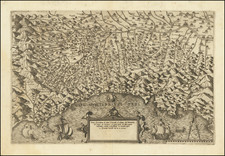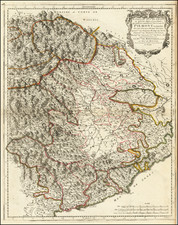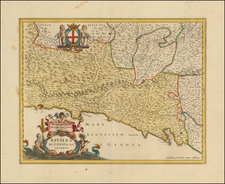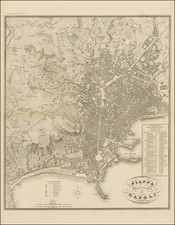Finely colored example of Blaeu's map of Campagna di Roma and Sabina, covering approximately the region of modern Lazio.
Produced by the Blaeu family, one of the most renowned cartographic publishers of the 17th century, this map is an exquisite representation of the countryside around Rome, once known as Latium, an area rich in history and the foundation of Roman culture. The title, translated from Latin, declares the map as depicting the "Countryside of Rome, formerly Latium: Patrimony of St. Peter and Sabina."
The map itself is a detailed depiction of the topography, administrative divisions, and infrastructure, including roads and settlements, of the areas surrounding Rome, extending into the Sabine territory. At the lower left of the map is a dedication cartouche to Cassiano del Pozzo, the grandson of the first minister of the Grand Duke of Tuscany, was a figure well-known in Roman intellectual circles. Pozzo was a patron of the arts, an avid collector, and a member of the circle of scholars known as the Accademia dei Lincei.
The allegorical title cartouche, which is a common feature in Blaeu's maps, blending artistry with cartography. The title cartouche is often a work of art in itself, rich with symbolic imagery. In this instance, it combines religious and regional iconography, reflecting the map's coverage of the Papal States, with St. Peter's keys prominently displayed, symbolizing the ecclesiastical authority over the region. The presence of an angel or putto is typical of the Baroque period, adding a touch of divine guidance or protection over the territory depicted.
Willem Janszoon Blaeu (1571-1638) was a prominent Dutch geographer and publisher. Born the son of a herring merchant, Blaeu chose not fish but mathematics and astronomy for his focus. He studied with the famous Danish astronomer Tycho Brahe, with whom he honed his instrument and globe making skills. Blaeu set up shop in Amsterdam, where he sold instruments and globes, published maps, and edited the works of intellectuals like Descartes and Hugo Grotius. In 1635, he released his atlas, Theatrum Orbis Terrarum, sive, Atlas novus.
Willem died in 1638. He had two sons, Cornelis (1610-1648) and Joan (1596-1673). Joan trained as a lawyer, but joined his father’s business rather than practice. After his father’s death, the brothers took over their father’s shop and Joan took on his work as hydrographer to the Dutch East India Company. Later in life, Joan would modify and greatly expand his father’s Atlas novus, eventually releasing his masterpiece, the Atlas maior, between 1662 and 1672.
Joan, or Johannes, Blaeu (1596-1673) was the son of Willem Janszoon Blaeu. He inherited his father’s meticulous and striking mapmaking style and continued the Blaeu workshop until it burned in 1672. Initially, Joan trained as a lawyer, but he decided to join his father’s business rather than practice.
After his father’s death in 1638, Joan and his brother, Cornelis, took over their father’s shop and Joan took on his work as hydrographer to the Dutch East India Company. Joan brought out many important works, including Nova et Accuratissima Terrarum Orbis Tabula, a world map to commemorate the Peace of Westphalia which brought news of Abel Tasman’s voyages in the Pacific to the attention of Europe. This map was used as a template for the world map set in the floor of the Amsterdam Town Hall, the Groote Burger-Zaal, in 1655.
Joan also modified and greatly expanded his father’s Atlas novus, first published in 1635. All the while, Joan was honing his own atlas. He published the Atlas maior between 1662 and 1672. It is one of the most sought-after atlases by collectors and institutions today due to the attention to the detail, quality, and beauty of the maps. He is also known for his town plans and wall maps of the continents. Joan’s productivity slammed to a halt in 1672, when a fire completely destroyed his workshop and stock. Joan died a year later and is buried in the Westerkerk in Amsterdam.












![[ Gonzaga Family History Dating Back to Constantinople ] Paleologi Imperatores Constantinopolitani, et Marchiones Montisferrati...](https://storage.googleapis.com/raremaps/img/small/99753.jpg)

![[ Republic of Genoa ] Liguria o Stato della Republica di Genova](https://storage.googleapis.com/raremaps/img/small/98618.jpg)